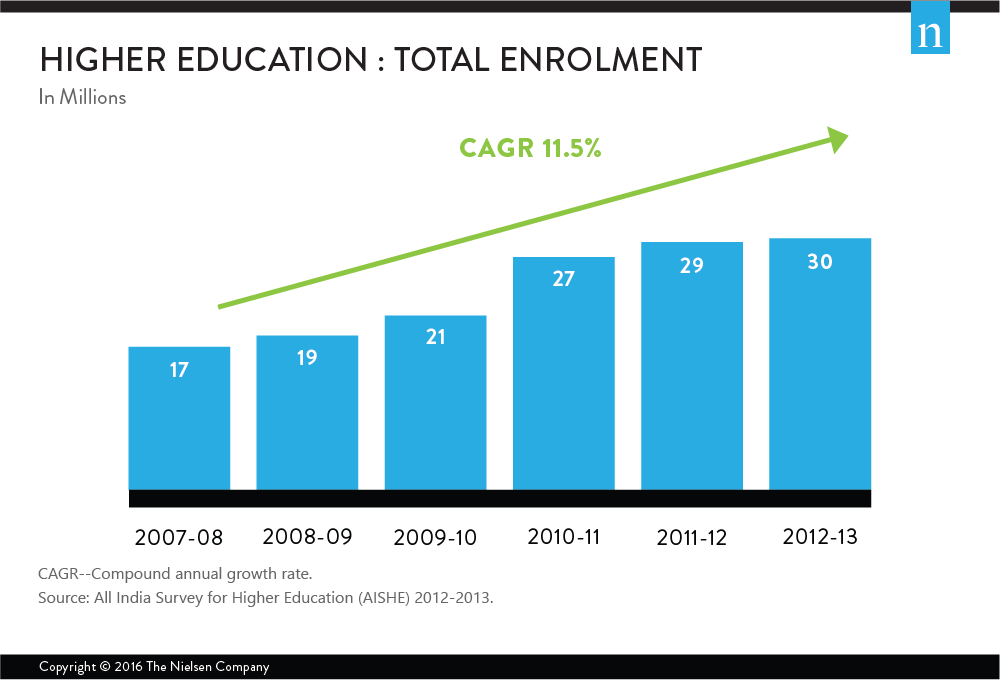La tasa de alfabetización de la India ha mejorado considerablemente en la última década, gracias en parte a las inversiones del Gobierno en educación. Según la Encuesta Nacional de Lectores Jóvenes de 2009, tres de cada cuatro jóvenes del país saben leer y escribir, y una cuarta parte de la población juvenil (la asombrosa cifra de 83 millones) se identifica como lectora de libros. Para 2020, se prevé que el nivel de alfabetización del país alcance el 90%.
Y eso tiene enormes implicaciones para la industria mundial del libro.
India es actualmente el segundo país más poblado del mundo, con más de 1.280 millones de habitantes. Y las previsiones de crecimiento demográfico estiman que India superará al país más poblado en la actualidad, China, a finales de 2030, con una población de unos 1.530 millones.
Además de este extraordinario crecimiento demográfico, la economía india también está en una senda de fuerte expansión, con un aumento medio anual del PIB del 8,6% en los últimos tres años. Esto convierte a la India en la economía de más rápido crecimiento del mundo.
Para comprender mejor el sector editorial en la India, Nielsen Book emprendió un importante proyecto de investigación que dio como resultado el Informe sobre el mercado del libro en la India. Además de examinar los parámetros económicos de la industria editorial y el tamaño del mercado del libro, el estudio también analizó los marcos y las políticas gubernamentales, y el impacto de las leyes modificadas sobre la edición de libros, los comportamientos de compra de libros y las características de los consumidores de libros en los diferentes tipos de edición.
¿Qué tipos de libros componen el mercado indio?
Aunque la lectura por placer es un componente importante del mercado y el público de libros comerciales generales (ficción, no ficción y libros infantiles no educativos) parece que va a crecer, los libros escolares representan la mayor parte del mercado general del libro del país. De hecho, se calcula que las compras de libros escolares de K-12 representan alrededor del 71% del mercado, mientras que los libros de enseñanza superior suponen un 22% adicional.

La población total de la India está cada vez más escolarizada. La tasa bruta de escolarización (TBM) para la enseñanza primaria y secundaria fue del 84,6% en 2013-2014, y la Comisión de Planificación ha previsto que esta cifra aumente hasta el 93,2% en 2017. Esto supondrá casi el 100% de matriculación en primaria, más del 90% en secundaria y el 65% en bachillerato. Las previsiones de Nielsen sobre el crecimiento del mercado de libros de texto indican que este mercado, ya de por sí muy importante, crecerá en torno a un 19% en los próximos cinco años, debido a que cada vez más niños van a la escuela -y permanecen en ella más tiempo- y a que cada vez más padres pueden permitirse los recursos necesarios para ayudarles en sus necesidades de aprendizaje.

Las características únicas de la demografía de la India en términos de crecimiento de la población, especialmente de los jóvenes alfabetizados y educados, también presentan enormes oportunidades para el crecimiento y la expansión de la industria editorial en todos los sectores, no sólo en la educación. Pero estas enormes oportunidades no están exentas de desafíos. Por ejemplo, la India tiene 22 lenguas oficiales y, con las lenguas regionales y dialectos de todos los estados, la cifra asciende a más de 1.600.
Además de tener que hacer frente a un mercado tan fragmentado demográficamente, las librerías físicas de la India también tienen que lidiar con la competencia de los nuevos canales de comercialización que ofrece el comercio electrónico. Estos minoristas en línea suelen ser, como en otros países, atractivos tanto en surtido como en precio para una población cada vez más móvil. Otros obstáculos son la geografía y el tamaño del país, así como la ineficacia y los costes que conlleva una infraestructura deficiente. Todo ello hace que la distribución de grandes volúmenes de libros a todas las partes del país sea un problema logístico para las editoriales.
A pesar de los muchos retos a los que se enfrenta el mercado del libro en India, la industria se está expandiendo rápidamente, creando puestos de trabajo y contribuyendo a la educación y alfabetización del país. Quienes trabajan en este sector vibrante, influyente y significativo creen que ha llegado el momento de que se le conceda el estatus de "industria" para que el comercio del libro pueda obtener apoyo financiero y colaborar más estrechamente con el gobierno en la promoción del desarrollo general del país.



